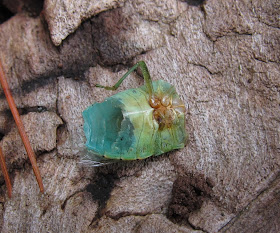It's true that Saturday was a gorgeous day, and my solitary walk along the Hudson River at Moreau presented beautiful views of sky and water and mountains and trees.
But that dreary Sunday was far more fun because Sue always sees things I overlook, even without her binoculars. Sue is the steward for the trail around Mud Pond at Moreau Lake State Park, so that's where we went to check on trail conditions. As this photo shows, much of the ice has melted from the pond. Sue is searching for waterfowl on the open water. She spied a few ducks along the opposite shore.
One of the first things Sue spotted along the trail was a scattering of snowfleas hopping about on the snow. Too small for me to see with my feeble eyes, these tiny critters are not fleas at all, in fact they are not even insects, despite their having six legs. They belong to a category of creatures called springtails, a name that refers to the organ tucked up under their abdomens that snaps them skyward, very much like a hopping flea. This is a much enlarged photo. Their actual size is about that of one antenna. It was quite a challenge to get a photo: as soon as I'd get one in focus, it would just disappear into thin air.
This time of year, we often walk along complaining about how boring the woods can be. But then our grumbles will be interrupted by something extraordinary, such as finding tiny shards of what looked like green glass among the chaff inside a hollowed-out log.
We probably would have dismissed those shards as some careless hiker's discarded plastic trash, but then Sue spied a spiky leg and a shred of wing among those bits and pieces. What an amazing color for a bug! I wonder what it could be? Or rather, could have been?
Another almost invisible find, itsy-bitsy slime-mold fruiting bodies speckled a well-rotted fallen log.
On the underside of that same log, I found a quite extensive patch of Ceramic Fungus (Xylobolus frustulatus). My Barron's mushroom guidebook refers to this fungus as "widespread but not common, distinctive and unusual," and notes that it prefers old debarked oak logs to fruit on.
Nearby that old debarked fallen oak was a patch of Maleberry shrubs (Lyonia ligustrina), immediately identifiable by the distinctive khaki color of its branches and the clusters of last summer's fruits still hanging from the twigs. Those fruits are still there because no critter will eat them, since they are as hard as stones, even when fresh. Another common name for this shrub is He-huckleberry, in reference to the flowers' never producing edible fruit. I think the little fruits are quite cute, like tiny pumpkins.
Decorating the snow-covered forest floor nearby was a miniature forest of Tree Clubmoss, golden sporestalks still intact above the evergreen leaves.
All around the pond, we found evidence of energetic beaver activity, with many trees, both large and small, recently toppled and de-twigged. Then, just as I was commenting on how seldom we ever see beavers' footprints despite the abundance of other signs, we came upon this collection of prints, the clearest either one of us has ever seen, showing both the big hind feet as well as the smaller front ones. Now I wish I had placed my own hand in this photo, to show that those hind feet are nearly as big as a human hand. Big enough that even I could see them!











Wow! Look at those Beaver prints! Even without a size reference, they look pretty darn big in the picture. So cool!
ReplyDeleteWhat a walk!
ReplyDeleteWhat photos!
A joy to see the beaver prints, not to mention the colors of the poor dead insect included.
The turquoise bug casing is unreal! Beautiful photos - spring IS coming!
ReplyDeleteHi Jackie. You and Sue never fail to find new and wonderful things. The remains of that green bug are familiar (the large, triangular green scutellum is a give-away). It's one of those bright green stink bugs. (By the way, the small winter stone flies -- Capniids -- are out on the snow now, too, and much easier to see than the springtails.)
ReplyDeleteThanks for your comments, dear friends. I love to know you are along with me on my hikes. A special thanks to Wayne for suggesting Stink Bug for the green bug scraps. Of course! Why didn't I think of that?
ReplyDelete